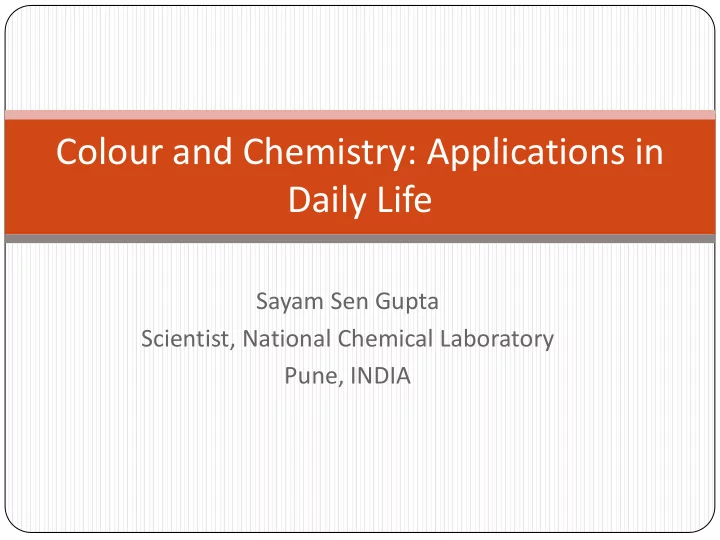

Colour and Chemistry: Applications in Daily Life Sayam Sen Gupta Scientist, National Chemical Laboratory Pune, INDIA
Chemical Indicators Any substance that gives a visible sign, usually by a colour change, of the presence or absence of a threshold concentration of a chemical species. Example: Acid-Base Indicators Phenolpthalein Water to Wine Acidic: Colorless Basic: Pink
Acid, Base and pH in a nutshell Bases Acids pH is a measure of the concentration of H + ions in a solution pH 0 7 14 Acid Neutral Base
Color and Molecular Structure • Light delivers energy in little packets called photons • Different colors of light pack different amounts of energy in their photons • All materials absorb photons of some energy. But only substances that absorb photons of visible light will have color • Different molecules absorb different colors of light, depending on their electronic structure
Mystery behind “Water to Wine” In Acid In Base Molecule not flat: Molecule flat: electron electron does not moves freely over move freely and most of molecular absorbs in the UV framework
Red Cabbage: Natural Indicator Red Cabbage 2.1 red 3.6 red-violet 5.9 violet 7.0 blue-violet 7.4 blue 9.8 blue-green Natural pH sensitive indicator > 12 green
Mood Lipsticks Product Description: Colour changes instantly according to body chemistry - Long lasting 12 hour lip colour - Moisturizes and protects with ALOE VERA and antioxidants Vitamins A, C & E
Methylene Blue: Redox Indicator Leucomethylene Blue Methylene Blue Reduction Oxidation Colorless Blue Solution contain Glucose, Methylene Blue and Sodium Hydroxide Reaction 1 Leucomethylene Blue Methylene Blue + Glucose + Sodium Gluconate Reaction 2 Methylene Blue + H 2 O Leucomethylene Blue + O 2
Methylene Blue as Oxygen Indicator • Presence of oxygen necessary for re-oxidation • If vial is not opened after each experiment to let in sufficient oxygen, the re-oxidation to methylene blue doesnot work • Can be used to determine the presence of oxygen in certain samples
Methylene Blue as indicator for testing milk quality Pasteurized (does not contain microorganisms) Milk Unpasteurized (contain bacteria such as lactobacillus sp ) Remains Blue Pasteurized Milk + Methylene Blue Slowly turns Unpasteurized Milk + Methylene Blue colorless
Indicators here, there, everywhere
Indicators to Detect Blood in Crime Scene Haemoglobin + H 2 O 2 ½ O 2 Reduced Phenolpthalein: Oxidized Phenolpthalein in Colorless Base: Pink
The Composition of Paint Paint is composed of colored pigment and a binder Pigment: Colored powdered substance (minerals, inorganic salts, dyes) Binder: Material that evenly disperses the pigment, adheres to surface when paint applied and then dries Additives: Such as Glycerine for brushability, antioxidants to prevent paint spoliage Paints are homogeneous mixtures, are uniform throughout
Brief but Colorful History of Paint Bison • Dated 35,000 years ago • Painted in cave walls by the Cro-Magnon man , our Paleolithic ancestors • Found in Lascaux, France Binder Pigment Saliva and animal fat
Earth’s Natural Palette Red Hematite: Iron Oxide Cinnabar: Contains mercury; toxic Blue Lazurite: Bright blue; very expensive Azurite: Blue with green tinge; basic copper carbonate much cheaper; used by Michelangelo
Earth’s Natural Palette Yellow and Orange Orpiment and Realgar: used as late till 19 th century when it was discovered to have arsenic. Van Gogh’s mental illness and Monet’s blindness were probably caused by it Green Malachite is a copper compound and is possibly the oldest known green pigment used.
Inorganic Salts as Pigments Colored Pigments can be formed by precipitation of aqueous ions in solution Yellow lead chromate Pb(NO 3 ) 2 + Na 2 CrO 4 PbCrO 4 + 2NaNO 3 White zinc hydroxide Zn(NO 3 ) 2 + NaOH Zn(OH) 2 + 2NaNO 3 Blue Copper Carbonate Cu(NO 3 ) 2 + Na 2 CO 3 CuCO 3 + 2NaNO 3
The Frescos Michelangelo: Created the most influential works in Fresco in the western art history Ceiling of Sistine Chapel, Creation of Adam Vatican City
Painting of Fresco’s and Secco’s: Egg Tempera • They were done mostly using egg tempera paint • It contains a colored pigment and the yolk of an egg mixed with water • The egg temperas were absorbed into freshly spread wet plaster and remained vibrant as long as the paint survived • The paint became part of the plaster
Making Binder for Egg Tempera The egg yolk will now be mixed with equal amount of water to make the binder
The pigment Yellow lead chromate Pb(NO 3 ) 2 + Na 2 CrO 4 PbCrO 4 + 2NaNO 3 White zinc hydroxide Zn(NO 3 ) 2 + NaOH Zn(OH) 2 + 2NaNO 3 Blue Copper Carbonate Cu(NO 3 ) 2 + Na 2 CO 3 CuCO 3 + 2NaNO 3
Oil Paintings Oil Paints , pigment combined with oil discovered in early 15 th century. Oil such as terpentine oil and linseed oil is the binder. Sunrise- An impression by Monet Starry Nights by Van Gogh
Acrylic paints and other medium Poster Paint Transparent Water Color
Art Restoration • Great works of art are susceptible to effects of aging, temperature and humidity changes, and exposure to light- needs to be conserved • Conservation involved cleaning the work, analyzing the work for damage, restoring the damaged areas and preserving the original • Understanding the usage of pigments and binders over ages is utmost important to carry out proper restoration
Fun Activity for you Create a pallet of natural paints. How? Find colored rocks. Grind each rock with a mortar and pestle. Add a binder to the powdered rock. Binders can be egg yolk, starch or even glue. Now you have paints. Use these paints in a drawing. Try to identify an element or a combination of elements that produce certain colors
Acknowledgement Mr. Mrityunjoy Kar Mr. Chakadola Panda Reference- Chemical Curiosities: Spectacular Experiments and Inspired Quotes by H. W. Roesky
Recommend
More recommend